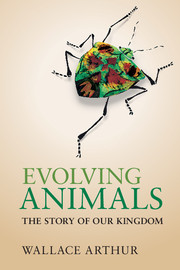Book contents
- Frontmatter
- Dedication
- Contents
- Preface
- Acknowledgements
- 1 What is an animal?
- 2 Before there were animals
- 3 How to make a fossil
- 4 The Cambrian explosion
- 5 How to make a species
- 6 Jellyfish and their kin
- 7 How to make a tree
- 8 The enigmatic urbilaterian
- 9 Animal symmetry and heads
- 10 A plethora of worms
- 11 Trends in animal complexity
- 12 Where the octopus is king
- 13 How to make an animal
- 14 Exoskeletons galore
- 15 Extinction
- 16 Mouth first, mouth second
- 17 Comparing embryos
- 18 Larvae, mouthparts and moulting
- 19 The animal toolkit
- 20 Vertebrate origins and evolution
- 21 From water to land to water
- 22 Variation and inheritance
- 23 Evolutionary novelties
- 24 Human origins and evolution
- 25 Animal plasticity
- 26 The nature of adaptation
- 27 The direction of evolution
- 28 Animal extremophiles
- 29 Extraterrestrial animals?
- 30 The ghost in the machine
- Appendix
- References
- Index
6 - Jellyfish and their kin
Published online by Cambridge University Press: 05 August 2014
- Frontmatter
- Dedication
- Contents
- Preface
- Acknowledgements
- 1 What is an animal?
- 2 Before there were animals
- 3 How to make a fossil
- 4 The Cambrian explosion
- 5 How to make a species
- 6 Jellyfish and their kin
- 7 How to make a tree
- 8 The enigmatic urbilaterian
- 9 Animal symmetry and heads
- 10 A plethora of worms
- 11 Trends in animal complexity
- 12 Where the octopus is king
- 13 How to make an animal
- 14 Exoskeletons galore
- 15 Extinction
- 16 Mouth first, mouth second
- 17 Comparing embryos
- 18 Larvae, mouthparts and moulting
- 19 The animal toolkit
- 20 Vertebrate origins and evolution
- 21 From water to land to water
- 22 Variation and inheritance
- 23 Evolutionary novelties
- 24 Human origins and evolution
- 25 Animal plasticity
- 26 The nature of adaptation
- 27 The direction of evolution
- 28 Animal extremophiles
- 29 Extraterrestrial animals?
- 30 The ghost in the machine
- Appendix
- References
- Index
Summary
In the previous chapter, we saw that many rounds of the speciation cycle from the starting point of a single stem species produce many species whose pattern of relationship can be illustrated in the form of an evolutionary tree. As time goes on, the number of extant species that constitute the growing tips of the tree’s branches increases, unless the number of species-deaths – through extinction – becomes large enough to balance the number of species-births, in which case the number of species stabilizes. If the number of deaths exceeds the number of births, then of course the size of the overall group of species declines.
When we look at a group of related species alive today, it’s natural to wonder what their stem species, or last common ancestor (LCA), was like. This often motivates searches for fossils representing possible candidates. However, while candidates can indeed be found, ascertaining whether any one of them actually was the stem of the group concerned is difficult. This is true even of small groups of species with a relatively recent origin – such as the great apes. It’s even more of a problem when dealing with large groups of species with an ancient origin.
- Type
- Chapter
- Information
- Evolving AnimalsThe Story of our Kingdom, pp. 56 - 66Publisher: Cambridge University PressPrint publication year: 2014



